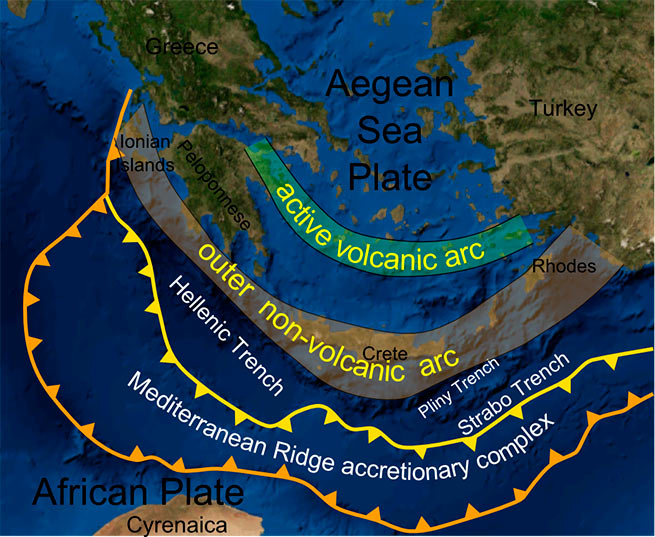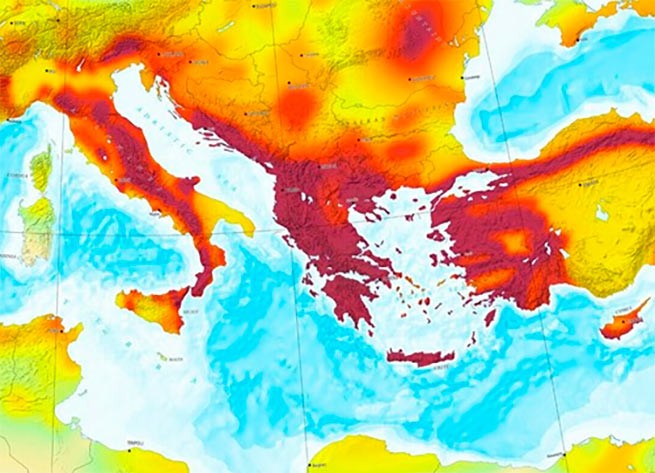Greek seismologists, having assessed the history of seismic activity in Greece, said that an earthquake with a magnitude of 8.5 on the Richter scale is waiting for her soon. This is much more than the catastrophic earthquake in Turkey, which killed tens of thousands of people in this country.
Greece is located in a complex border zone in the eastern Mediterranean Sea at the junction of the African and Eurasian lithospheric plates, between which the Lesser Aegean Plate is located.
Professors Konstantinos Sinolakis and Kostantinos Papazahos studied the circumstances of a series of earthquakes in Turkey and Syria. On the air of MEGA TV Sinolakis declaredthat Greece can also expect strong seismic activity.
Konstantinos Sinolakis pointed out that strong earthquakes in Greece occur once every 600 years.
“The last major earthquake (above magnitude 8) in Crete happened in 1403, and according to my estimates, such earthquakes occur every 600-800 years. We are already on the verge of an earthquake measuring about 8.5 on the Richter scale,” said Sinolakis.
Kostas Papazachos, professor of seismology at the Aristotle University of Thessaloniki, pointed out that the Greek region is at risk of strong seismic activity. So, in 1953 there was an earthquake of magnitude 7.2 in Kefalonia. In 1956, earthquakes of magnitude 7.5 were recorded on the island of Amorgos.
“In Greece, such earthquakes have already occurred, and this should make us think: how we will react, and what will happen in the appropriate case”Papazachos emphasized, adding that “at some point we will experience such an earthquake with modern buildings and we will have to deal with the consequences”specifying, however, that such earthquakes in Greece “usually have limited effects, mainly because they most often occur in maritime areas.”
Asked early in the interview if an earthquake like the one in Turkey could be predicted, he replied, “We can’t predict exactly when an earthquake will occur,” and recalled disasters such as the 1822 Aleppo earthquake, which is estimated to have killed between 20,000 and 60,000 people, and in Ethiopia in 1939. Papazachos said such earthquakes are not rare in these regions, “so we know we’ve had them for centuries.”
“Especially at the end of the 19th century, we had about 4-5 of these earthquakes until the beginning of the 20th century, which led to destruction on the northeastern part of this particular fault. Therefore, this is not a prediction here in the sense that we all understand that “tomorrow “There will be an earthquake the day after tomorrow, get out of your homes,” but we certainly knew that this area was getting very, very big accelerations, and the official specifications for this area were extremely strict,” Papazakos said.
Both scientists agreed that their forecasts should not be taken as a prediction. Rather, this is a warning that the authorities should pay attention to in order to have time to prepare the population for possible problems.
As we reported previously, February 6, two powerful earthquakes with an interval of several hours occurred in Turkey and Syria. According to the latest data, the death toll exceeded 46.8 thousand people.
Reference: seismic activity in Greece.
Greece is located in a complex border zone in the eastern Mediterranean Sea at the junction of the African and Eurasian lithospheric plates, between which the Lesser Aegean Plate is located.
The northern part of Greece is part of the Eurasian Plate, while the southern part is part of the Aegean Plate. The Aegean plate is moving southwest relative to the Eurasian plate at a rate of 30 mm per year. And the African Plate is slowly sinking under the Aegean Plate at a rate of 40 mm per year. In the north, at the point of contact between the Aegean and Eurasian plates, a divergent boundary is formed, and in the south, a convergent boundary, which is referred to as the Aegean arch.

It’s no secret that earthquakes in Greece are not uncommon. Seems to be unfavorable seismological conditions – this is a kind of retribution before nature for the wonderful climate and the blessed nature of the Mediterranean. These phenomena, formidable and incomprehensible, have been known to the lands of Hellas since time immemorial: even the well-known term seismos comes from the Greek language and denotes what it means – “earthquake”.
The strongest earthquakes in Greece in the entire history of observations have always occurred at the southern boundary of the plates, in the so-called Aegean arch. However, the equipment did not record a single earthquake with a magnitude greater than 7.2 points. Where the African Plate plunges under the Aegean, the epicenter of the earthquake is often located at a great depth, more than 50 km, and the magnitude of earthquakes is usually more than 7 points. However, such earthquakes do not bring with them much destruction, although they are very well felt.
In total, there are 19 active tectonic faults in the Aegean Sea in Greece, which can cause an earthquake with a magnitude of over 7 on the Richter scale.
Directly near Athens (50 km) there are 2 volcanoes, one of them, in Methana, is active. At the same time, in the Saronic Gulf there is a seismically active tectonic fault.

We recommend reading: Beware the earthquake
The northern part of Greece is part of the Eurasian Plate, while the southern part is part of the Aegean Plate. The Aegean plate is moving southwest relative to the Eurasian plate at a rate of 30 mm per year. And the African Plate is slowly sinking under the Aegean Plate at a rate of 40 mm per year. In the north, at the point of contact between the Aegean and Eurasian plates, a divergent boundary is formed, and in the south, a convergent boundary, which is referred to as the Aegean arch.

It’s no secret that earthquakes in Greece are not uncommon. Seems to be unfavorable seismological conditions – this is a kind of retribution before nature for the wonderful climate and the blessed nature of the Mediterranean. These phenomena, formidable and incomprehensible, have been known to the lands of Hellas since time immemorial: even the well-known term seismos comes from the Greek language and denotes what it means – “earthquake”.
The strongest earthquakes in Greece in the entire history of observations have always occurred at the southern boundary of the plates, in the so-called Aegean arch. However, the equipment did not record a single earthquake with a magnitude greater than 7.2 points. Where the African Plate plunges under the Aegean, the epicenter of the earthquake is often located at a great depth, more than 50 km, and the magnitude of earthquakes is usually more than 7 points. However, such earthquakes do not bring with them much destruction, although they are very well felt.
In total, there are 19 active tectonic faults in the Aegean Sea in Greece, which can cause an earthquake with a magnitude of over 7 on the Richter scale.
Directly near Athens (50 km) there are 2 volcanoes, one of them, in Methana, is active. At the same time, in the Saronic Gulf there is a seismically active tectonic fault.

We recommend reading: Beware the earthquake







More Stories
Crete "shaking" – two earthquakes this morning
Ecological… tombstones
Landslide on Santorini